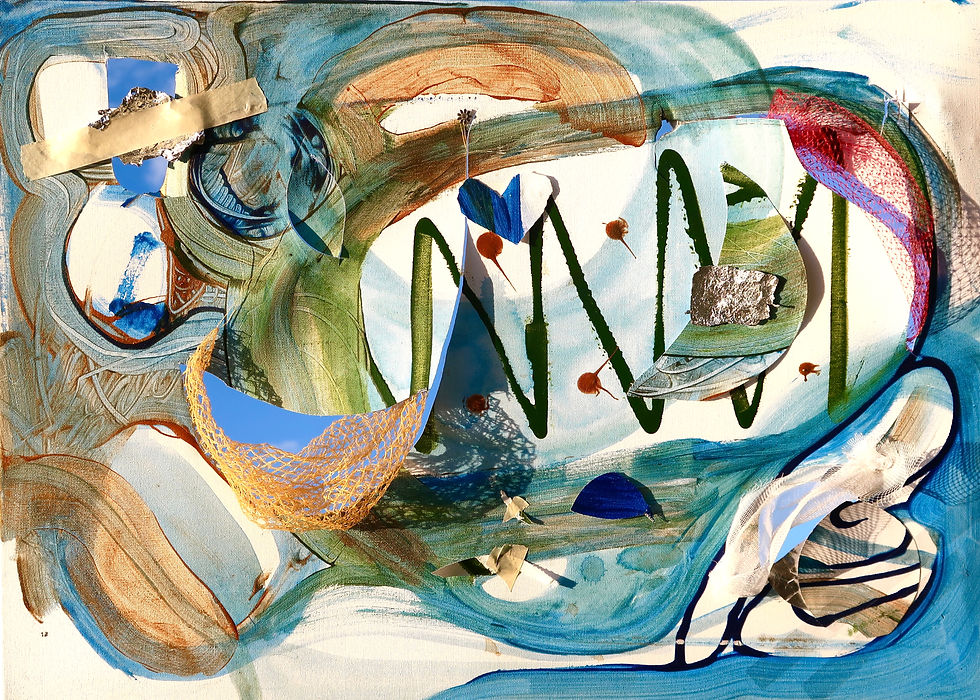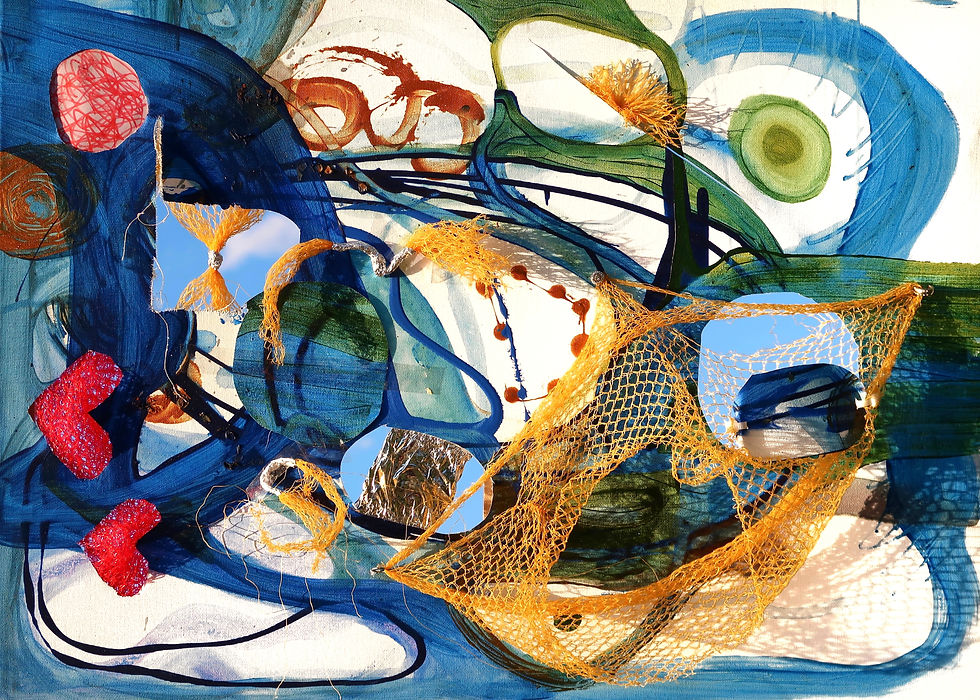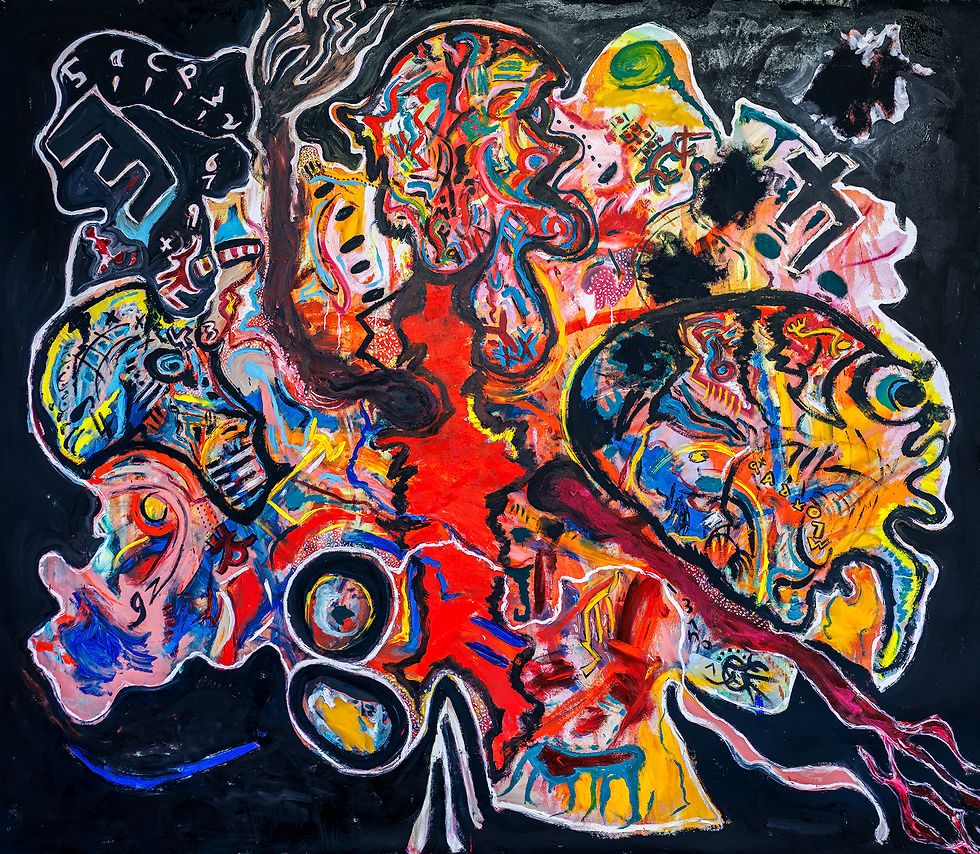Media Platform &
Creative Studio
Magazine - Narratives of Care
A testament to the interconnectedness of all things with Vesta Vaitkute
Joana Alarcão
Step into the captivating world of Vesta Vaitkutė, where the spontaneity of life unfolds through the canvas of her artistic expressions. With a deep-rooted belief that everything true, real, and beautiful stems from spontaneity, Vesta weaves a mesmerizing narrative that intertwines the molecular dance of particles, the movement of stars, and the essence of human existence into her art.
12 August 2024



Born in Lithuania (y. 2002) is a contemporary artist who combines scientific and philosophical disciplines into art.
She was raised with freedom to do anything she wants and independence from her parents. In her teenage years, she was skipping class to paint and started to become addicted to art. Besides that, her obsession with mystery of life extended into astrology and witchcraft. Soon, she started to see patterns between astrology, personalities and seasons. Her interests compounded into art where she is able to connect the dots between variety of disciplines.
When Vesta graduated art school in 2019, she wanted to experiment and started to work as a makeup artist. In this practice she painted over 2500 people in a 5 year span and had space for experimentation since makeup is a temporary art. ,,Women were always muses for me, even when I am painting something abstract, womanly shapes are inevitable part of the painting.”
She gravitates towards Niki de Saint Phalle, Miró and Gaudi as they delve into the consiousness through painting to express it as simply and honestly as possible.
With her art, she is curious to express the stories of people as cells flying in cosmos. In 2023, she started to travel and witnessed many lives in Europe. In a one year span she had traveled and visited galleries in Paris, Barcelona, Malaga, Southampton, Dublin, Florence, Sienna, Rome, Naples, Berlin, Portugal, Lithuania.
,,What is fascinating, everyone wants to know the origin of where we come from, no matter your profession, personality, it seems like this question is ingrained since birth.”
Direction
Can you start by giving us an overview of your practice and what led you to explore the intersection of consciousness, art, and care?
My journeys in Europe led me to paint, as everything was constantly changing while art provided a sense of stability. Consciousness is all that we are, yet we cannot define or understand that. Art could be the closest thing that could depict it. Since we don’t understand it, I think we should just enjoy it and let it do its thing - which is to create. From creation, there comes a sense of meaning and a desire to contribute. I feel abundant in a lot of ways, gratitude towards that is expressed through sharing the art with the public.
I look at the world as an alien, because I want to have an objective overview of the world. That is the reason I engage in science and philosophy to gain different perspectives on existence.
In your statement, you mention that you want to “capture nature's symbiotic rhythm from microbic and cosmic perspectives.” How do you balance the logical and intuitive aspects of understanding nature in your creative process, especially when incorporating scientific and philosophical concepts into your art?
I think art is a portal to our subconscious, it shows what is beneath the surface and in the exploration of cells and the cosmos, I feel that everything is connected both from an intuitive and scientific standpoint.
The scientific standpoint is seen in the paintings, as I noticed the structures of cells captured on canvas when I later learned more about molecular biology. The intuitive nature is in the process, painting grows as a separate entity in front of my eyes.
My intention is to project what I’ve learned from my internal journey - everything I’ve experienced and seen in life was served intentionally by the universe, nothing is random. As much as you would try to mix things up, and act irrational, random or crazy - there is always a reason behind nature. Science and philosophy are languages that define what is happening between human nature and the human soul.
As humans, we are explorers, as people, we are professionals, who are trying to identify as someone. Tapping into the explorer’s way of looking at things is when we feel the most freedom in life.
I may say that there is a possibility to dedicate as much time to scientific research and feed your brain as there is to explore the unknown which is essentially following your intuition. Science is intuitive in some way, we make hypotheses on studies in the same way that we make hypotheses on our future. It is beautiful how we progressed as a humanity and society through our curiosity. Curiosity is something that separates us from other animals and makes us more eager to advance in technology, art and culture.

Can you share more about the concept of "spontaneity of life" and how it influences your artistic perspective and creative process?
Curiosity. It's all there is in life.
We were cells once, I think it’s fascinating how we evolved. Cells experimented for a billion years on planet Earth and they never stopped till the environment aligned with them and water appeared, that's when the first cell was born. To put yourself into perspective and see that you and everything around you come from one seed, from one atom is humbling and powerful. It makes us feel connected from the beginning of time. Whether you believe in scientific theory, or religious dogma or you don't believe in anything, one thing that unites us all is the first life on Earth and the fact that we were only one cell at some point.
My creative process stems from this playful approach to art and my love for the spontaneity of life. I conduct experiments as if it's a lab of art, a lab of consciousness and a lab of love. Surprise occurs every time I create as I don’t know where the painting will go. I go with the flow and never take my art too seriously or personally because it only reflects a small fraction of my existence.
How did your experience working in a monastery in Umbria influence the themes and techniques in your first and second collections?
I went to the monastery by chance and my intention was to see life more clearly, without the city, technology and distractions. I was completely isolated. It was one of the best decisions in my life.
The 17 paintings were produced in a one-month period while I was working 8-10 hours every day.
I had time to think about the paintings while I was working, constructing the painting before it was born.
Every day we would go to the chapel to meditate, I would see beautiful shapes in my mind and I would paint them. Abstractions often took the shape of a seed, a coffee bean particularly, I guess it symbolizes dualism.
A lot of emotional baggage was released through art as I had time to distance myself from essentially everything that made me who I am. I had an identity shift, as there was no contact from family, friends, no past career. This emptiness was filled with exploration of cells and cosmos, and curiosity to understand the world around me as I was free to think and be whatever I wanted to be. Honest, raw and unapologetic, holding onto values that feel intuitively right to me.
There were visitors from New York, London, Amsterdam and other cities that were interested in this hermit lifestyle and I took an opportunity to show the art to them. It was an entertaining experiment from which I understood more the people, more the paintings and was encouraged to progress further.
The most important thing I realized about art through this experiment, was that interpretation of art says more about the interpreter than the art itself.
As a living organism it provokes, makes you feel, and think whatever you need to feel and when it is fully understood, its story is finished, it becomes boring, it becomes kitsch.
Without anyone witnessing the art and giving it a look - it becomes dead. We make art special by our interpretation.

You mentioned that painting acted as a form of therapy for you. Can you elaborate on this therapeutic aspect of painting?
Living in a monastery there was a pressure and discomfort to be outside of my previous identity. With painting, you can better define your existence and stand with that. I realized this lesson later.
But the primary intention was just to witness more color combinations, such as blue, I missed the visual stimulation. Everyday I saw the same mountains, stairs, tiles, only the food and people were changing, which I think is the most important change that can happen. The therapeutic aspect of experimenting with colors acted as a healing and calming practice while also providing stimulation.
It's fascinating that you incorporated elements from everyday life, such as vegetable nets, into your art. How did these unconventional materials come into your practice?
It is more fascinating that we have created so many great inventions and we are so advanced that we can throw them out without a second thought. So far, as a human race, we come to realize our mistakes as rushing too much for a little reward and hustling so much only to end up not having time to enjoy life. Building so much only to miss nature.
Trash can tell a story, textures give us a feeling. Seeing an everyday item in a different context will change the perception of it, thus using it more carefully and consciously. It also encourages the use of not only visual but also sensual perception.
In this III collection where I use trash - every painting is an episode of an ecological disaster and it is left to be interpreted by the viewer.
Molecular biology, astronomy, and the philosophy of Alan Watts and Terrence McKenna have influenced your fourth collection. How do these diverse influences manifest in your artwork, and what do you aim to convey through this collection?
These 4 influences are the essential part of my art at the moment. Understanding the sensitivity of the cell and the mystery of genes have manifested as bright colors interacting with each other. This story progresses into the sky, where we see collisions that look brutal, but also happen, as Alan Watts would suggest, for a good reason. Listening to Terence McKenna I see humanity as the force that we should trust, especially during times when we question technology’s impact on humans and its ability to control our impulses. With this collection, my aim is to progress naturally as a human being and also convey a message that everything falls into place, trust the process, trust the chaos, embrace the unknown and search for new.

Can you provide more details about your submitted work, the piece titled "Biodiversity"? What are the inspirations and creative processes behind this particular artwork?
Biodiversity is the first work that enters into the trash era. In this painting there are marine organisms that have become one with the trash, they have mutated and now use trash as armor. It is portrayed in a funny but also tragic way. It looks like a party of fish and their beautiful foil gowns, but at the end it's not where they belong.
It is a connection with how fish may feel in their environment at the moment and also how we may feel isolated in the parties in this digital era. There is a connection between our doubt of nature and nature’s naivety that results in disasters.
The biggest message of this painting is the loss of biodiversity and the emerging diversity of trash. Both in the ocean and in our minds.

Do you believe that engaging in artistic expression is a mode of nurturing? If so, what are the reasons behind this perspective?
It is water for your soul if we interpret it as a plant. When art is produced, it holds medicine inside which then heals society. It is needed for survival as much as shelter and food. In ancient times, before learning to verbally communicate, we were telling stories through painting in the caves, leaving a testament of existence for many generations to come. The art we create today is not only for us but also for the future generations to come.
What message or call to action would you like to leave our readers with?
Everyone has a good story to tell. Hold the vision of your creation with conviction that it has happened and watch it come into your life. Enjoy this slowly, don’t rush, life is already so short, lengthen it by focusing on one thing at a time.
Find more about the artist here.
Cover Image:
Space cells by Vesta Vaitkute. Image courtesy of Vesta Vaitkute.







